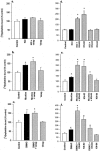Differential effects of chronic drug treatment on alpha3* and alpha7 nicotinic receptor binding sites, in hippocampal neurones and SH-SY5Y cells
- PMID: 11498514
- PMCID: PMC1621156
- DOI: 10.1038/sj.bjp.0704207
Differential effects of chronic drug treatment on alpha3* and alpha7 nicotinic receptor binding sites, in hippocampal neurones and SH-SY5Y cells
Abstract
1. The aim of this study was to compare the effects of chronic treatment (for 4 or 7 days) with nicotinic drugs and 20 mM KCl on numbers of surface alpha7 nicotinic AChR, identified by [(125)I]-alpha bungarotoxin (alpha-Bgt) binding, in primary hippocampal cultures and SH-SY5Y cells. Numbers of alpha3* nicotinic AChR were also examined in SH-SY5Y cells, using [(3)H]-epibatidine, which is predicted to label the total cellular population of predominantly alpha3beta2* nicotinic AChR under the conditions used. 2. All the nicotinic agonists examined, the antagonists d-tubocurarine and methyllycaconitine, and KCl, upregulated [(125)I]-alpha Bgt binding sites by 20 - 60% in hippocampal neurones and, where examined, SH-SY5Y cells. 3. Upregulation of [(125)I]-alpha-Bgt binding sites by KCl was prevented by co-incubation with the L-type Ca2+ channel blocker verapamil or the Ca2+-calmodulin dependent kinase II (CaM-kinase II) inhibitor KN-62. Upregulation of [(125)I]-alpha-Bgt binding sites by nicotine or 3,[(4-dimethylamino) cinnamylidene] anabaseine maleate (DMAC) was insensitive to these agents. 4. [(3)H]-Epibatidine binding sites in SH-SY5Y cells were not affected by KCl but were upregulated in a verapamil-insensitive manner by nicotine and DMAC. KN-62 itself provoked a 2 fold increase in [(3)H]-epibatidine binding. The inactive analogue KN-04 had no effect, suggesting that CaM-kinase II plays a role in regulating numbers of alpha3* nicotinic AChR. 5. These data indicate that numbers of alpha3* and alpha7 nicotinic AChR are modulated differently. Nicotinic agonists and KCl upregulate alpha7 nicotinic AChR through distinct cellular mechanisms, the latter involving L-type Ca2+ channels and CaM-kinase II. In contrast, alpha3* nicotinic AChR are not upregulated by KCl. This difference may reflect the distinct physiological roles proposed for alpha7 nicotinic AChR.
Figures




Similar articles
-
Long-term exposure to the new nicotinic antagonist 1,2-bisN-cytisinylethane upregulates nicotinic receptor subtypes of SH-SY5Y human neuroblastoma cells.Br J Pharmacol. 2005 Dec;146(8):1096-109. doi: 10.1038/sj.bjp.0706434. Br J Pharmacol. 2005. PMID: 16273122 Free PMC article.
-
Inducible, heterologous expression of human alpha7-nicotinic acetylcholine receptors in a native nicotinic receptor-null human clonal line.Brain Res. 1999 Apr 17;825(1-2):172-9. doi: 10.1016/s0006-8993(99)01066-5. Brain Res. 1999. PMID: 10216184
-
Up-regulation of human alpha7 nicotinic receptors by chronic treatment with activator and antagonist ligands.Eur J Pharmacol. 1998 Apr 17;347(1):131-9. doi: 10.1016/s0014-2999(98)00084-3. Eur J Pharmacol. 1998. PMID: 9650859
-
The brain alpha7 nicotinic receptor may be an important therapeutic target for the treatment of Alzheimer's disease: studies with DMXBA (GTS-21).Behav Brain Res. 2000 Aug;113(1-2):169-81. doi: 10.1016/s0166-4328(00)00211-4. Behav Brain Res. 2000. PMID: 10942043 Review.
-
Recent progress in the development of subtype selective nicotinic acetylcholine receptor ligands.Curr Drug Targets CNS Neurol Disord. 2002 Aug;1(4):337-48. doi: 10.2174/1568007023339256. Curr Drug Targets CNS Neurol Disord. 2002. PMID: 12769608 Review.
Cited by
-
Cellular responses to nicotinic receptor activation are decreased after prolonged exposure to galantamine in human neuroblastoma cells.Br J Pharmacol. 2005 Aug;145(8):1084-92. doi: 10.1038/sj.bjp.0706278. Br J Pharmacol. 2005. PMID: 15937519 Free PMC article.
-
Farnesyl Transferase Inhibitor Lonafarnib Enhances α7nAChR Expression Through Inhibiting DNA Methylation of CHRNA7 and Increases α7nAChR Membrane Trafficking.Front Pharmacol. 2020 Dec 29;11:589780. doi: 10.3389/fphar.2020.589780. eCollection 2020. Front Pharmacol. 2020. PMID: 33447242 Free PMC article.
-
Targeting brain α7 nicotinic acetylcholine receptors in Alzheimer's disease: rationale and current status.CNS Drugs. 2014 Nov;28(11):975-87. doi: 10.1007/s40263-014-0201-3. CNS Drugs. 2014. PMID: 25248971 Review.
-
Effects of chronic drug treatments on increases in intracellular calcium mediated by nicotinic acetylcholine receptors in SH-SY5Y cells.Br J Pharmacol. 2002 Feb;135(4):1051-9. doi: 10.1038/sj.bjp.0704508. Br J Pharmacol. 2002. PMID: 11861334 Free PMC article.
-
A novel effect of PDLIM5 in α7 nicotinic acetylcholine receptor upregulation and surface expression.Cell Mol Life Sci. 2022 Jan 10;79(1):64. doi: 10.1007/s00018-021-04115-y. Cell Mol Life Sci. 2022. PMID: 35013841 Free PMC article.
References
-
- ALKONDON M., ALBUQUERQUE E.X. Diversity of nicotinic acetylcholine receptors in rat hippocampal neurons. I. Pharmacological and functional evidence for distinct structural subtypes. J. Pharmacol. Exp. Ther. 1993;265:1455–1473. - PubMed
-
- BARRANTES G.E., ROGERS A.T., LINDSTROM J., WONNACOTT S. α-Bungarotoxin binding sites in rat hippocampal and cortical cultures: initial characterisation, colocalisation with α7 subunits and up-regulation by chronic nicotine treatment. Brain Res. 1995;672:228–236. - PubMed
-
- BENCHERIF M., FOWLER K., LUKAS R.J., LIPPIELLO P.M. Mechanisms of up-regulation of neuronal nicotinic acetylcholine receptors in clonal cell lines and primary cultures of fetal rat brain. J. Pharmacol. Exp. Ther. 1995;275:987–994. - PubMed
-
- BENWELL M.E.M., BALFOUR D.J.K., ANDERSON J.M. Evidence that tobacco smoking increases the density of (−)-[3H]-nicotine binding sites in human brain. J. Neurochem. 1988;50:1243–1247. - PubMed
-
- BREESE C.R., MARKS M.J., LOGEL J., ADAMS C.E., SULLIVAN B., COLLINS A.C., LEONARD S. Effect of smoking history on [3H]-nicotine binding in human postmortem brain. J. Pharmacol. Exp. Ther. 1997;282:7–13. - PubMed
Publication types
MeSH terms
Substances
LinkOut - more resources
Full Text Sources
Other Literature Sources
Miscellaneous

